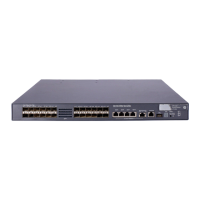167
NOTE:
• You must make sure that the source device and the destination device can communicate at Layer 2 in
the remote probe VLAN.
• For the mirrored packets to be forwarded to the monitor port, make sure that the same probe VLAN
is configured in the remote source and destination mirroring groups.
• To make the port mirroring function work properly, before configuring bidirectional traffic mirroring
on a port in a mirroring group, you must use the mac-address mac-learning disable command on
the source device, intermediate devices, and destination device to disable the MAC address learning
function for the remote port mirroring VLAN. For more information about the mac-address mac-
learning disable command, see
Layer 2—LAN Switching Command Reference
.
CAUTION:
For a mirrored packet to successfully arrive at the remote destination device, you must make sure that
the VLAN ID carried in the packet is correct (the same as the probe VLAN ID). If the VLAN is removed
or the VLAN ID is changed, the Layer 2 remote port mirroring configuration becomes invalid.
Layer 3 remote port mirroring
Layer 3 remote port mirroring is implemented through the cooperation of a remote source mirroring group,
a remote destination mirroring group, and a GRE tunnel, as shown in Figure 66.
Figure 66 Layer 3 remote port mirrori
ng implementation
On the source device, packets of the mirroring port (or CPU) are mirrored to the tunnel interface that
serves as the monitor port in the remote source mirroring group, and then transmitted to the destination
device through the GRE tunnel. The destination device receives the mirrored packets from the other tunnel
interface that serves the mirroring port in the remote destination mirroring group, and then forwards the
packets to the monitor port in the remote destination mirroring group. In this way, the data monitoring
device connected to the monitor port on the destination device can monitor and analyze packets passing
through the mirroring port (or CPU) on the source device.
NOTE:
For more information about GRE tunnels, see
Layer 3—IP Services Configuration Guide
.

